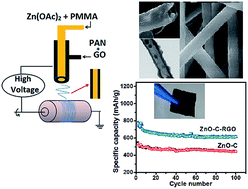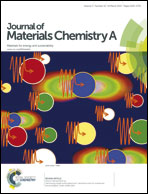Electrospun hollow glassy carbon–reduced graphene oxide nanofibers with encapsulated ZnO nanoparticles: a free standing anode for Li-ion batteries†
Abstract
Although zinc oxide (ZnO) has a high theoretical capacity for lithium (Li) storage, it has poor cyclability because of the huge volume changes during charge–discharge cycles resulting in particle pulverization and detachment from the current collector. In this paper, a novel anode architecture for Li-ion batteries fabricated by encapsulation of ZnO nanoparticles in the hollow core of glassy carbon–reduced graphene oxide (C–rGO) electrospun composite nanofibers, is described. A one-step, co-axial electrospinning method is used to synthesize a mat of core–shell structured composite nanofibers composed of rGO embedded in poly(acrylonitrile) (shell) and a ZnO nanoparticle precursor with a carrier polymer (core). Subsequent calcination and carbonization produce a mechanically stable anode material, which is used directly as a free-standing anode (∼60 μm thick) without any binder and current collector, which are inactive materials that only add to the battery mass and volume. The ZnO–C–rGO nanofiber composite was characterized by scanning electron microscopy, transmission electron microscopy, Raman spectroscopy and X-ray diffraction. The electrochemical performance of the composite was studied by galvanostatic charge–discharge measurements at different current densities, slow scan cyclic voltammetry (CV) and impedance measurements. Incorporation of an rGO network in the glassy nanofiber shell enhances both the capacity and electrical conductivity of the mat electrode resulting in faster electron kinetics, and thus, an improved rate capability. The interior void spaces combined with the mechanical strength and flexibility of the C–rGO shell act as a structural buffer effectively relieving the volumetric stresses generated during charge–discharge cycles. The synergistic effect of the metal oxide, rGO and the core–shell design results in a high capacity of 815 mA h g−1 at a current density of 50 mA g−1 with capacity retention of almost 80% after 100 cycles, thus demonstrating significant potential as an anode substitute for next generation Li-ion batteries.


 Please wait while we load your content...
Please wait while we load your content...